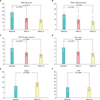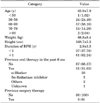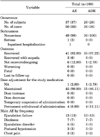Abstract
Purpose
To evaluate the efficacy and safety of silodosin 8 mg once daily in a 12-week treatment of subjects with severe lower urinary tract symptoms (LUTS) associated with benign prostatic hyperplasia (BPH).
Materials and Methods
A total of 100 subjects from 10 urology centers in Korea were included in this study. The inclusion criteria were as follows: age ≥50 years, International Prostate Symptom Score (IPSS) ≥20, quality of life (QoL) score ≥3, urine volume ≥120 mL and maximal urinary flow rate (Qmax) <15 mL/s, and postvoid residual volume (PVR) <100 mL. We assessed the improvement of LUTS with change in IPSS, QoL score, Qmax, PVR, and adverse events at baseline and 4 and 12 weeks after treatment with silodosin 8 mg once daily.
Results
The IPSS values were 23.27±3.34, 15.89±6.26, and 13.80±6.31 at baseline, 4, and 12 weeks, respectively, with significant improvements (p<0.0001, p=0.0214, respectively). QoL scores were 4.44±0.85, 3.38±1.20, and 3.04±1.20 at baseline, 4, and 12 weeks, respectively, and the differences were statistically significant (p<0.0001). There was a significant difference in Qmax between baseline and 12 weeks (p<0.0001) but not in PVR (p=0.9404) during the clinical trial. The most frequent adverse event in this study was ejaculation failure with 13 cases. However, no subject dropped out because of ejaculation failure, and in 12 of the 13 cases it was fully resolved without further treatment.
Benign prostatic hyperplasia (BPH) is frequently observed in elderly men. An estimated 70% of men in their 60s are suffering from BPH, and 10% to 20% of them have been reported to need medical treatment [1,2]. With South Korea becoming an aging society, a rising number of Korean men have signs and symptoms of BPH, drawing much public attention.
The medications for the management of BPH include α1A-adrenoceptor blockers and 5α-reductase inhibitors (5-ARIs). Currently, α1A-adrenoceptor blockers are commonly used as the first-line treatment for the relief of BPH symptoms [3,4]. They can be used regardless of prostate size because they act on the neurally mediated contraction of the muscular stroma that is increased in BPH [5].
Silodosin is a new selective antagonist of α1A-adrenoceptors, which are located in the human prostate and bladder neck. Blockade of these α1A-adrenoceptors can cause smooth muscle in these tissues to relax, resulting in an improvement in urine flow and a reduction in lower urinary tract symptoms (LUTS). Silodosin appears less likely to cause cardiovascular side effects because it has a low selectivity for α1B-adrenoceptors involving blood pressure control [6,7]. In a recent large multinational study, silodosin was demonstrated to be an effective and safe treatment for the relief of BPH symptoms. In addition to significant effects in patients with moderate symptoms (International Prostate Symptom Score [IPSS]≥8-19), silodosin resulted in significant improvements in total IPSS over placebo in patients with severe symptoms (IPSS≥20) [8,9]. However, homogeneous data for patients with severe LUTS associated with BPH are currently sparse for Asian populations.
Given the above background, this prospective multicenter study evaluated the efficacy and safety of silodosin 8 mg once daily in a 12-week treatment of patients with severe LUTS associated with BPH in a Korean population.
Between December 2010 and September 2011, a 12-week, prospective, single-open-label, multicenter clinical study was conducted in 10 institutions in Korea. When subjects who were suspected of having LUTS associated with BPH visited each institution, the investigators assessed their eligibility for the study and checked the selection criteria. The ethics committee of each participating institution approved this clinical study, and each subject gave written informed consent before beginning any investigational procedure.
Four visits were foreseen: a screening visit (V1, obtaining informed consent, conducting items for V1, and asking the patients to revisit the site within 2 weeks), at baseline (V2, prescribing silodosin 8 mg once daily after confirming the selection criteria), and after 4 (V3) and 12 weeks (V4) of treatment. If the subjects failed to visit on the designated day, their results were evaluated for efficacy and safety within the visit window. Adverse events (AEs) were recorded at each visit after treatment.
All subjects who had been diagnosed with BPH through transrectal ultrasonography met the following criteria: age≥50 years, IPSS≥20, quality of life (QoL) score≥3, urine volume≥120 mL and maximal urinary flow rate (Qmax)<15 mL/s, and postvoid residual volume (PVR) measured by ultrasonography<100 mL. Principal exclusion criteria were a previous history of any procedure considered an intervention for BPH, intrapelvic radiation, active urinary tract infection or history of neurogenic bladder, bladder calculus, conducting self-catheterization, history of prostate cancer, renal impairment with a serum creatinine concentration ≥2.0 mg/dL, severe hepatic disorders (total bilirubin ≥2.5 mg/dL or aspartate aminotransferase/alanine aminotransferase 2.5 times higher than the normal upper level), severe arrhythmia, cardiac failure, cardiac infarction, unstable angina, cerebral infarction within 6 months, significant postural hypotension, history of administered silodosin, use of other α1A-adrenoceptor blockers within 1 month, use of antiandrogens except 5-ARIs within 1 year, or phytotherapy within 3 months before entry.
The primary endpoint of this study was the efficacy of silodosin 8 mg once daily for improvement of severe LUTS associated with BPH. This was measured by the change in IPSS total score (primary efficacy variable) before and after treatment. The secondary efficacy variables were as follows: change in IPSS voiding and storage scores, QoL score, Qmax, and PVR between visits.
A 5% level of significance was used for all statistical tests, and all statistical tests were two-sided. All statistical analyses were performed by using SAS 9.2 (SAS Institute Inc., Cary, NC, USA).
The total number of subjects was set at 100. To evaluate the efficacy and safety of silodosin, the change in IPSS total score from the reference was -10.1 points of the subjects whose IPSS total score at baseline had been over 20 points [10]. We assumed that the difference might not exceed 2.1 points. Under a significance level of 2.5% and power of 90%, considering a dropout rate of 10%, the study required a total of 100 subjects.
The intention-to-treat (ITT) population consisted of all subjects who had a result of the primary efficacy variable after taking silodosin at least once. The per-protocol (PP) population consisted of subjects in the ITT population who adhered to the 12-week schedule without severe violations and who had a drug compliance rate of 75% or higher. The safety population consisted of all subjects who participated in the study and took at least one dose of silodosin.
In this study, excluding 3 subjects who dropped out during the screening period, 100 subjects enrolled. The 100 enrolled subjects were all included in the safety evaluation. The ITT population, the main subject of evaluation of primary efficacy variable, consisted of 98 subjects, excluding 1 subject who withdrew consent and 1 subject with a protocol violation. The PP population, which consisted of 92 subjects, excluded 4 subjects who withdrew consent, 1 subject with a protocol violation, and 1 subject with an AE.
Descriptive statistics were used to describe the primary efficacy variable data produced at each visit. Change from baseline to 12 weeks was compared by using a paired-test. The same method was used for the secondary efficacy variable.
Descriptive statistics were used to describe the laboratory data, vital signs, and electrocardiogram (ECG) test data produced at each visit. Change was compared by using a paired-test or a McNemar's test. All AEs were standardized as system organ class and by preferred terms by use of the World Health Organization adverse reactions terminology (WHOART 092).
Table 1 shows the demographics of the ITT population. The subjects had a mean age of 63.9±7.0 years. Concerning medical history, the prevalence period of BPH was 2.9±3.5 years. Thirty-one patients (31.63%) had received previous oral therapy during the 6 months before this study. However, they had not been administered an α1A-adrenoceptor blocker within 1 month of study enrollment. Fifty-nine patients (60.20%) received concomitant treatments during this clinical trial, including 3 patients who took 5-ARIs.
Fig. 1 shows the changes in efficacy variables of the ITT population. The IPSS total score for the ITT population showed a statistically significant decrease of 9.47±6.22 (p=0.0214). The PP population also showed a statistically significant decrease of 9.78±6.20 (p=0.0070). There was also a statistically significant decrease in the IPSS storage and voiding subscores (p<0.0001 for both scores). Change in QoL score for the ITT and PP populations recorded a statistically significant decrease of 1.40±1.22 (p<0.0001) and 1.46±1.24 (p<0.0001), respectively. The changes in Qmax from baseline were 3.54±6.60 mL/s for the ITT population (p<0.0001) and 3.29±6.46 mL/s for the PP population (p<0.0001), both of which were statistically significant. On the other hand, the changes in PVR were not statistically significant for either the ITT population or the PP population, which were 0.33±42.25 mL (p=0.9404) and 0.93±42.42 mL (p=0.835), respectively. Silodosin was effective for improving subjective symptoms with a significant change in IPSS Q1 score (incomplete emptying) (p<0.0001).
Table 2 shows the AEs and adverse drug reactions (ADRs). Among 100 subjects, 50 cases of AEs occurred in 37 subjects (37.0%), and of those, 36 cases of ADRs occurred in 26 subjects (26.0%).
The most frequently occurring AE was ejaculation failure with 13 cases. However, these were all mild cases, and administration of silodosin was continued. In 12 of 13 cases, the AE was fully recovered without further treatment. One serious AE occurred and required hospitalization due to pancreatitis. However, this AE was considered to have a low relationship with the investigational product, and the subject recovered without any sequela. One subject withdrew from the study because of AEs. The investigational product was discontinued due to headache and dizziness and those AEs disappeared after the discontinuation of administration.
Laboratory test, ECG test, and vital sign test results indicated no significant influences on the clinical study results. Cardiovascular AEs such as postural hypotension were observed (3%). However, no subjects withdrew from the study because of cardiovascular AEs.
BPH frequently causes bothersome LUTS such as urinary frequency, nocturia, and urgency. Among the α1-adrenoceptor subtypes, it was shown that α1A-adrenoceptors are mainly involved in constriction due to sympathetic nerves in the LUTS [3,5]. Therefore, clinicians should preferentially prescribe drugs that are highly selective toward the LUTS. Silodosin, the newest agent to treat BPH efficiently with its high selectivity for α1A-adrenoceptors and safety, is receiving attention [10].
In a United States clinical study, Marks et al. [11] reported the efficacy and safety of silodosin 8 mg (once daily) for the treatment of BPH in two randomized placebo-controlled phase 3 studies. Of 923 patients with a mean age of 65 years, 466 received silodosin 8 mg and 457 were given placebo for 12 weeks. After 3 to 4 days of treatment, patients receiving silodosin showed significant improvements in IPSS total scores (p<0.0001), storage symptoms (p=0.0002), and voiding symptoms (p<0.0001) compared with the placebo group. The mean change from baseline in IPSS total score was -4.2 for silodosin versus -2.3 for placebo, and the differences between treatments in IPSS total score and subscores increased by week 12 (p<0.0001).
In phase 3 clinical studies performed in Europe, an improvement in the change from baseline in IPSS was reported for the silodosin 8 mg (once daily) group and tamsulosin 0.4 mg group compared with placebo (-7.0 for silodosin, p<0.001; -6.7 for tamsulosin, p<0.001) [8]. This study showed silodosin to be an effective drug for the treatment of both storage and voiding LUTS associated with BPH because a statistically significant and potentially clinically relevant difference versus placebo was observed in the IPSS total score, in the storage and voiding subscores, and in QoL due to urinary symptoms. The treatment effect with silodosin appeared to be at least equivalent to and numerically consistently greater than that seen with tamsulosin when considering the change from baseline in the IPSS total score, in the voiding subscore, and in the responder rates, even if the differences were not statistically significant.
Recently, several western studies reported that silodosin also showed significant improvements in total IPSS over placebo in patients with severe symptoms (IPSS≥20) [8,9]. However, studies using homogeneous data only for Asian patients with severe LUTS associated with BPH are currently sparse. Our clinical study was performed to evaluate the efficacy and safety of silodosin for 12 weeks for severe BPH patients (IPSS≥20) in Korea. In this study, silodosin was proven to be effective for severe LUTS associated with BPH by the statistically significant decrease in IPSS total score and QoL score. Combination therapy of α-blocker and anticholinergics is frequently used to treat storage symptoms, but this clinical study has shown silodosin to be an effective monotherapy in treating storage symptoms of BPH by relieving not only the voiding symptoms but also the storage symptoms. The efficacy of silodosin may result from the reduction of obstruction at the bladder outlet by α1A-adrenoceptor antagonists during voiding as there are α1A-adrenoceptors at the bladder neck and proximal urethra [12,13,14,15].
Referring to the results at baseline, 4, and 12 weeks, in all variables evaluated, silodosin showed rapid symptom relief within 4 weeks of administration. In the case of severe BPH, which mostly influences the patient's QoL, the rapid relief of LUTS by initial administration would be an important factor in choosing drugs.
Silodosin with its higher selectivity for α1A-adrenoceptors than other α1-blockers improves LUTS with minimal cardiovascular adverse reactions [6,8,10,16]. In preclinical study results, silodosin showed a high affinity for α1A-adrenoceptor, 162 times more selective for α1A than α1B and 148 times more selective for prostate than blood vessels [6,17]. During the present clinical study, minor differences in blood pressure or pulse were observed, and the occurrences of cardiovascular adverse events were low (3%). Therefore, silodosin can be considered a safe and effective medication for BPH patients. On the other hand, adverse events related to ejaculation mostly occurred due to the high electivity of silodosin toward α1A-adrenoceptors, which also influence the seminal vesicles and ejaculatory duct. However, ejaculation disorder, a reversible symptom which fully recovers after the termination of administration, also appears with other α1A-adrenoceptor antagonists and no subjects discontinued the administration.
Silodosin was proven to be effective for severe LUTS by the statistically significant decreases in total IPSS and QoL scores. As expected for a highly α1A-adrenoceptor-selective drug, silodosin appears to be a safe drug for severe BPH patients. Treatment with silodosin produced significant improvement in the LUTS of patients with severe LUTS who received sustained treatment for 12 weeks. Silodosin was well tolerated with a low incidence of cardiovascular events. Therefore, silodosin is an effective and safe treatment for the relief of severe LUTS (IPSS≥20) associated with BPH in patients in Korea.
Figures and Tables
 | FIG. 1Change in efficacy variables. The p-values are computed from paired t-test. IPSS, International Prostate Symptom Score; QoL, quality of life; Qmax, maximal urinary flow rate; PVR, postvoid residual volume. |
References
1. Wasserman NF. Benign prostatic hyperplasia: a review and ultrasound classification. Radiol Clin North Am. 2006; 44:689–710.
2. Thorpe A, Neal D. Benign prostatic hyperplasia. Lancet. 2003; 361:1359–1367.
3. Madersbacher S, Alivizatos G, Nordling J, Sanz CR, Emberton M, de la Rosette JJ. EAU 2004 guidelines on assessment, therapy and follow-up of men with lower urinary tract symptoms suggestive of benign prostatic obstruction (BPH guidelines). Eur Urol. 2004; 46:547–554.
4. Fine SR, Ginsberg P. Alpha-adrenergic receptor antagonists in older patients with benign prostatic hyperplasia: issues and potential complications. J Am Osteopath Assoc. 2008; 108:333–337.
5. Lepor H. Alpha blockers for the treatment of benign prostatic hyperplasia. Rev Urol. 2007; 9:181–190.
6. Tatemichi S, Kobayashi K, Maezawa A, Kobayashi M, Yamazaki Y, Shibata N. Alpha1-adrenoceptor subtype selectivity and organ specificity of silodosin (KMD-3213). Yakugaku Zasshi. 2006; 126(Spec no.):209–216.
7. Schilit S, Benzeroual KE. Silodosin: a selective alpha1A-adrenergic receptor antagonist for the treatment of benign prostatic hyperplasia. Clin Ther. 2009; 31:2489–2502.
8. Chapple CR, Montorsi F, Tammela TL, Wirth M, Koldewijn E, Fernandez Fernandez E, et al. Silodosin therapy for lower urinary tract symptoms in men with suspected benign prostatic hyperplasia: results of an international, randomized, double-blind, placebo- and active-controlled clinical trial performed in Europe. Eur Urol. 2011; 59:342–352.
9. Yoshida M, Kudoh J, Homma Y, Kawabe K. Safety and efficacy of silodosin for the treatment of benign prostatic hyperplasia. Clin Interv Aging. 2011; 6:161–172.
10. Kawabe K, Yoshida M, Homma Y. Silodosin Clinical Study Group. Silodosin, a new alpha1A-adrenoceptor-selective antagonist for treating benign prostatic hyperplasia: results of a phase III randomized, placebo-controlled, double-blind study in Japanese men. BJU Int. 2006; 98:1019–1024.
11. Marks LS, Gittelman MC, Hill LA, Volinn W, Hoel G. Rapid efficacy of the highly selective alpha1A-adrenoceptor antagonist silodosin in men with signs and symptoms of benign prostatic hyperplasia: pooled results of 2 phase 3 studies. J Urol. 2009; 181:2634–2640.
12. Malloy BJ, Price DT, Price RR, Bienstock AM, Dole MK, Funk BL, et al. Alpha1-adrenergic receptor subtypes in human detrusor. J Urol. 1998; 160(3 Pt 1):937–943.
13. Rossi M, Roumeguère T. Silodosin in the treatment of benign prostatic hyperplasia. Drug Des Devel Ther. 2010; 4:291–297.
14. Capitanio U, Salonia A, Briganti A, Montorsi F. Silodosin in the management of lower urinary tract symptoms as a result of benign prostatic hyperplasia: who are the best candidates. Int J Clin Pract. 2013; 67:544–551.
15. Ding H, Du W, Hou ZZ, Wang HZ, Wang ZP. Silodosin is effective for treatment of LUTS in men with BPH: a systematic review. Asian J Androl. 2013; 15:121–128.
16. Marks LS, Gittelman MC, Hill LA, Volinn W, Hoel G. Silodosin in the treatment of the signs and symptoms of benign prostatic hyperplasia: a 9-month, open-label extension study. Urology. 2009; 74:1318–1322.
17. Murata S, Taniguchi T, Takahashi M, Okada K, Akiyama K, Muramatsu I. Tissue selectivity of KMD-3213, an alpha(1)-adrenoreceptor antagonist, in human prostate and vasculature. J Urol. 2000; 164:578–583.




 PDF
PDF ePub
ePub Citation
Citation Print
Print




 XML Download
XML Download